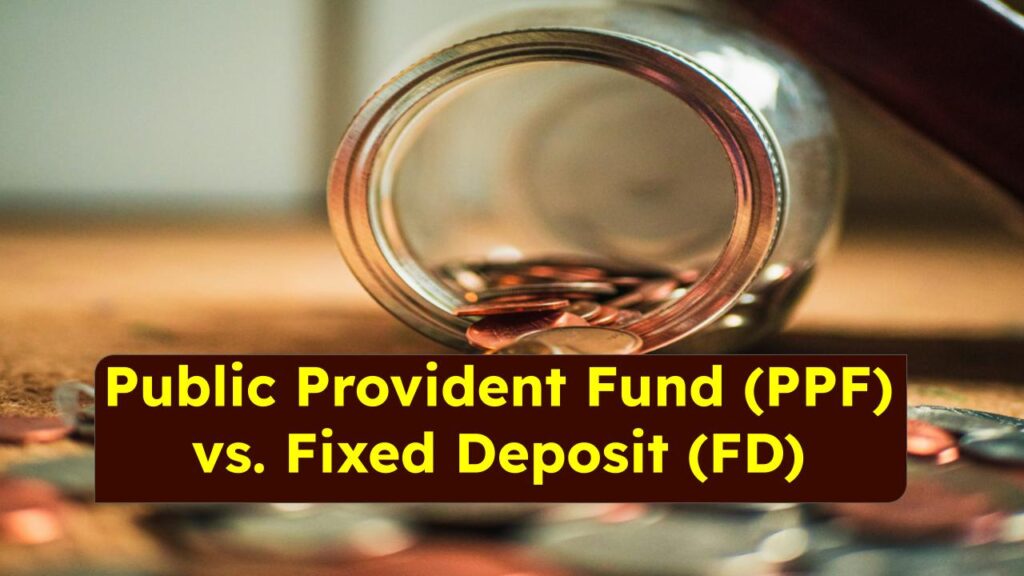
When it comes to saving money, two popular options in India are the Public Provident Fund (PPF) and Fixed Deposits (FD). Both are safe, reliable, and widely used, but they serve different purposes and offer varying tax benefits.
Public Provident Fund (PPF) vs. Fixed Deposit (FD)
| Aspect | PPF | FD |
|---|---|---|
| Tax Benefits | EEE (Exempt-Exempt-Exempt) status | Taxable interest (except Tax-Saver FD under Section 80C) |
| Interest Rate (2023) | ~7.1% p.a. (compounded annually) | 6.5%–8.5% p.a. (varies by bank) |
| Lock-in Period | 15 years (extendable) | 7 days–10 years (5 years for Tax-Saver FD) |
| Risk | Government-backed, zero risk | Low risk (DICGC insured up to ₹5 lakh) |
| Liquidity | Partial withdrawals after 5 years | Flexible, but penalties for premature withdrawals |
| Best For | Long-term goals (retirement, education) | Short-term goals or liquidity needs |
Choosing between PPF and FD depends on your financial goals, risk appetite, and tax bracket. PPF is ideal for long-term, tax-free growth, while FDs offer flexibility and higher interest rates for short-term needs. By understanding the pros and cons of each, you can make a decision that aligns with your financial plan.
What is PPF? A Safe Haven for Long-Term Savings
The Public Provident Fund (PPF) is a government-backed savings scheme designed to encourage long-term savings. It offers tax-free returns and is ideal for goals like retirement, children’s education, or buying a house. Here’s why PPF stands out:
- Tax Benefits (EEE Status):
- Contributions: Deductible under Section 80C (up to ₹1.5 lakh/year).
- Interest: Tax-free (currently ~7.1% p.a.).
- Maturity: Entire corpus (principal + interest) is tax-exempt after 15 years.
- Compounding Power: Interest is compounded annually, meaning your money grows faster over time.
- Safety: Backed by the Indian government, PPF is one of the safest investment options available.
- Flexibility: You can open a PPF account at any post office or authorized bank. The minimum deposit is ₹500/year, and the maximum is ₹1.5 lakh/year.
What is FD? A Flexible Option for Short-Term Needs
A Fixed Deposit (FD) is a savings instrument offered by banks and financial institutions. You deposit a lump sum for a fixed period (ranging from 7 days to 10 years) and earn interest. FDs are popular for their flexibility and predictable returns. Here’s what you need to know:
- Types of FDs:
- Regular FD: Interest is taxable, and TDS applies if interest exceeds ₹40,000/year (₹50,000 for seniors).
- Tax-Saver FD: Offers tax deductions under Section 80C but has a 5-year lock-in. Interest is taxable.
- Interest Rates: Vary by bank and tenure, typically ranging from 6.5% to 8.5% p.a.
- Liquidity: You can withdraw funds before maturity, but penalties may apply.
- Safety: FDs are low-risk, but only up to ₹5 lakh per bank is insured by the Deposit Insurance and Credit Guarantee Corporation (DICGC).
Read Also: Invest in THESE 5 Special Fixed Deposit Schemes Before 31 March 2025
PPF vs. FD: Which Offers Better Tax Benefits?
The key difference between PPF and FD lies in their tax treatment. Let’s compare:
1. Tax Efficiency
- PPF: Offers EEE (Exempt-Exempt-Exempt) status, meaning contributions, interest, and maturity are all tax-free.
- FD: Only Tax-Saver FD offers deductions under Section 80C. Interest is fully taxable, reducing net returns.
Example: If you invest ₹1.5 lakh in PPF and FD (Tax-Saver) at 7% interest:
- PPF: After 15 years, you get ~₹40.68 lakh (tax-free).
- FD: After 5 years, you get ~₹21.07 lakh, but interest is taxed annually, reducing net returns.
2. Effective Returns
- PPF: Post-tax return = Stated rate (e.g., 7.1% remains 7.1%).
- FD: Post-tax return = Interest rate × (1 – tax slab).
Example: For a 30% tax slab, a 7% FD yields ~4.9% post-tax.
3. Long-Term vs. Short-Term Goals
- PPF: Best for long-term goals due to its 15-year tenure and tax-free growth.
- FD: Suitable for short-term goals or emergency funds due to its flexibility.
How to Choose Between PPF and FD
- Assess Your Goals:
- Choose PPF for long-term goals like retirement or education.
- Opt for FD if you need liquidity or have short-term goals.
- Consider Tax Implications:
- If you’re in a high tax bracket, PPF’s tax-free returns make it more attractive.
- For senior citizens, FDs may offer higher interest rates (~7.5–8%), but remember the tax impact.
- Diversify Your Portfolio:
- Combine PPF with equity investments (e.g., ELSS) to maximize Section 80C deductions and diversify returns.
- Monitor Interest Rates:
- PPF rates are revised quarterly by the government, while FD rates vary by bank. Stay updated to make informed decisions.
Frequently Asked Questions About Public Provident Fund (PPF) vs. Fixed Deposit (FD)
1. Can I withdraw money from PPF before 15 years?
Yes, partial withdrawals are allowed after 5 years, but only for specific purposes like medical emergencies or higher education.
2. Is PPF better than FD for senior citizens?
It depends. FDs may offer higher interest rates for seniors, but PPF’s tax-free returns make it a better choice for long-term savings.
3. Can I have both PPF and FD?
Absolutely! Combining both can help you balance long-term growth and short-term liquidity needs.
4. What happens if I don’t extend my PPF account after 15 years?
Your account will stop earning interest, but you can withdraw the corpus tax-free.
